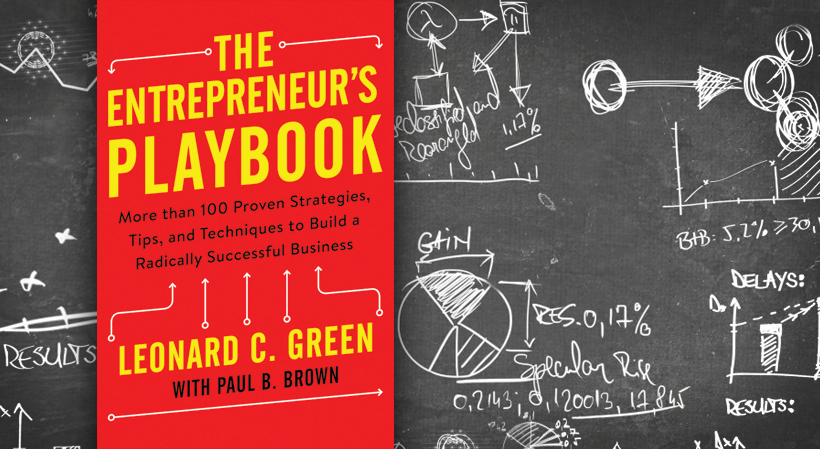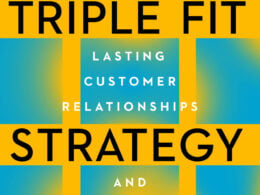The following excerpt is provided exclusively to StartupNation by “The Entrepreneur’s Playbook: More than 100 Proven Strategies, Tips, and Techniques to Build a Radically Successful Business” by Leonard C. Green with Paul Brown © 2017 Leonard C. Green All rights reserved. Published by AMACOM Books. www.amacombooks.org Division of American Management Association. 1601 Broadway, New York, NY 10019.
Successful entrepreneurs are not risk-takers; they are calculated risk-takers
Here’s a question most of my students get wrong, and you likely will too. (Don’t feel bad; just about everyone answers it incorrectly).
Ready? What is the number one characteristic of an entrepreneur?
The vast majority of my students—and everyone else I ask—-usually say, “They’re risk-takers.” If I’m feeling generous, I’ll reward my students with partial credit for this answer, but I probably shouldn’t.
The number one characteristic of successful entrepreneurs is that they are Calculated Risk-Takers. The difference between risk-takers and calculated risk-takers is the difference between failure and success.
Risk-takers bet it all on one roll of the dice. If they fail, they fail spectacularly—and in such a way that they don’t live to fight another day. They literally go out in a blaze of attempted glory.
This is not what the best entrepreneurs do. They figure out a way to reduce risk with every step they take. They follow the Act. Learn. Build. Repeat. model that we talked about in Principle 4 and they take small steps toward their goals. Before they take those small steps, they figure out a way to minimize their modest investment even further. They ask, “How can I take this step more cheaply (and/or by using someone else’s money); how can I do it faster (so I don’t have to invest as much time), and how can I do it better than I had initially planned?”
Indeed, the process of minimizing risks begins long before you take this first step:
What are others doing wrong?
What are others doing right?
Let’s start at the beginning. Before you make any move to create a new product or service, you want to study not only the specific area where you think you’re going to concentrate, but also the industry as a whole, in order to be able to select a niche where you can excel. (You can see why this principle—which deals with minimizing risks—follows the last one, How to Spot an Opportunity).
Related: Improve Your Skills, Increase Your Value [Book Excerpt]
No, you will never know what’s truly going on in a market before you enter it. And no, you don’t want to do a lot of homework, because you don’t want your potential opportunity to pass you by while you are doing research. But before you invest your time and money, you do want to gain a thorough understanding—either by yourself or by creating a team of people who have knowledge of the industry—of what the competition is doing.
Almost always, when I say this, people instantly jump to what the competition is doing wrong and what opportunities they’re missing. And it is, indeed, an extremely important thing to do. You want to find places that they may have overlooked, or could be underserving. The list in the last chapter—where we talked about the importance of upgrading, downgrading, bundling, etc.—could help you a lot here.
What you want to do is find ways you are different.
Minimizing risks 101
If you’re going into business with other people, the Act. Learn. Build. Repeat. model we talked about in Principle 4 is a great way to minimize the risks that come with starting a new company.
But even before you take your first steps toward creating anything new, there are things you can do administratively to reduce your risks even further. For some of you, the following advice is going to seem basic, but you would be amazed by how many people don’t take one or more of these following four steps:
- Form a business organization/entity that provides tax and business flexibility and protects your assets. I usually recommend a Limited Liability Corporation (LLC) so creditors cannot go after your personal assets should your venture fail
- Have liability insurance
- If you have partners, create an operating agreement that covers what happens to the business if one of you dies, gets divorced, becomes seriously ill or leaves the business
- Create a buy/sell agreement. Agree on criteria for the valuation of the company. I recommend that the agreement reflect that the parties will agree on a valuation expert to establish the valuation, and that that decision is binding
These four simple steps go a long way toward minimizing risks.
Important note: draw up this arrangement as the venture is just getting under way. It’ll be easier to get everyone in agreement, since no one will know who might be affected in the future.
For example, you run a small hardware store and see that Home Depot and Lowe’s are moving into your neighborhood. Instead of saying, “We’re doomed,” really study their stores. If you do, you’ll see that their very size can be used against them. Sure, they carry just about everything, but it’s extremely difficult to find any one specific item within their acres of selling space and their service—to be kind—is spotty. If you have a helpful staff and carry most things that people need to fix up and enjoy their homes, you should continue to do very well.
And don’t forget to look at what the competition is doing right: that’s another way of minimizing risk. There may be a way to build off what they have already proven to work. This is one of our great strengths at Blue Buffalo pet food company. We now have more than six hundred different product offerings. Most of the ideas stem from our CEO, Bill Bishop, who was also the marketing man behind SoBe beverages. Bill is always keeping his eye on the competition. While I’ve never stopped to count, my guess is that a large number of the ideas for our new products came from an improvement of a competitor’s product.
For example, Blue Buffalo saw that one of the smaller pet-care companies was selling a new kind of kitty litter, one made from wood chips. We started looking into the concept of using wood, and eventually that led us to begin experimenting with crushed walnut shells, which proved to be an excellent deodorizer. Our walnut-based kitty litter is a solid seller for us.
Minimizing risks should be an integral part of your company’s strategy.
I can’t begin to tell you the number of companies that get lax about this as they grow, always to their detriment.
Often people resist borrowing (and then improving) ideas that someone else had first. This is just silly. If your intent is to reduce the chances of failing, why wouldn’t you want to borrow something that has already proven to be successful and improve upon it, taking advantage of your strengths? In Blue Buffalo’s case, once we improve an existing idea, we can plug the product into our distribution networks. Stores are always looking for new products. Blue Buffalo has grown in sales and shelf space by constantly adding new products our customers want to buy.
You can’t assume you know everything. If you think you do, it will cripple your organization.
You shouldn’t care about where the idea was invented if it helps solve your customers’ needs. The idea is to always deliver new products and services as cheaply and simply as possible, with little risk, while providing value that the customer will appreciate.
Related: Sign up to receive the StartupNation newsletter!
“The Entrepreneur’s Playbook” is available now wherever fine books are sold, and at StartupNation.com.
Reviews of “The Entrepreneur’s Playbook”
“Succinct, smart, and unexpected advice on starting and running a business.”
–Library Journal
“(‘The Entrepreneur’s Playbook’ is) full of practical advice for aspiring entrepreneurs, including easy ways to identify sure-bet opportunities.”
– Huffington Post
“Lessons and content in ‘The Entrepreneur’s Playbook’ are life changing and unique. The reader learns to think differently, gain confidence and become a calculated risk taker. As Steve Jobs said, ‘Think differently. Be one of the crazies that changes the world.’ This book will you with real world tools to do so.”
–CEO Forum magazine






